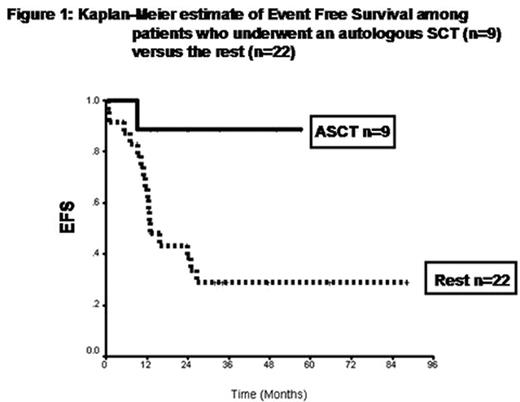Abstract
Arsenic trioxide (ATO) is the most effective agent in inducing remission among patients with relapsed acute promyelocytic leukemia (APL). After induction of remission in relapsed patients with ATO the best consolidation regimen remains to be defined. Since January 2000, 33 patients with relapsed APL were treated at our center. The median age was 35 years (range: 6 – 57) and there were 16 (48.5%) males. The initial treatment was conventional ATRA plus chemotherapy in 22 (66.7%) and single agent ATO in 11 (33.3%). The median duration of first remission was 19.4 months (range: 2.9 – 81.2). Relapse was treated with single agent ATO in 22 (66.7%), with ATO+ATRA in 5(15.2%) and with ATO+ATRA+anthracycline in 6 (18.2%). Thirty one (94%) achieved CR while one patient died of sepsis in induction and one died from progressive disease. After remission induction a consolidation course of the same agents used in induction was administered (ATO and ATRA were administered for 28 days), 29 (88%) achieved molecular remission after this course. All patients who achieved molecular remission were offered an autologous SCT. Nine patients opted to have an autologous SCT and the remaining patients were scheduled to receive monthly cycles of ATO as a single agent (n=15) or ATO+ATRA (n=7) for 6 months. The age, sex, duration of first CR, induction and consolidation regimen used to treat relapse was comparable between the patients that underwent an autologous SCT and the remaining patients. Patients who underwent an autologous SCT were conditioned with a conventional Bu/Cy regimen and received PBSC graft with a median cell dose of 5 x 106 MNC/Kg (range: 3.54 – 9.24). There were no treatment related deaths following the autologous SCT, one patient had an isolated CNS relapse 6 months post transplant. There were no other relapses or deaths in this group. Among the remaining patients who achieved CR but did not have an autologous SCT (n=22), 14 relapsed and all except one of these patients eventually died of progressive disease at median period of 1.6 months from second relapse (range: 0 – 42.6). At a median follow up of 24 months, the 3-year Kaplan-Meier estimate of EFS and OS among those who received an autologous SCT vs. those that did not was 88.9±10.5 vs. 28.8±9.7 (log rank: P=0.019) (Figure 1) and 100±00 vs. 36.2±10.4 (log rank: P=0.009) respectively. Following remission induction with ATO based regimens in patients with relapsed APL, consolidation with an autologous SCT, in those who achieve a molecular remission, is associated with a significantly superior clinical outcome in comparison to alternative ATO/ATRA based consolidation and maintenance regimens.
Kaplan-Meier estimate of Event Free Survival among patients who underwent an autologous SCT (n=9) versus the rest (n=22)
Kaplan-Meier estimate of Event Free Survival among patients who underwent an autologous SCT (n=9) versus the rest (n=22)
Author notes
Disclosure: No relevant conflicts of interest to declare.


